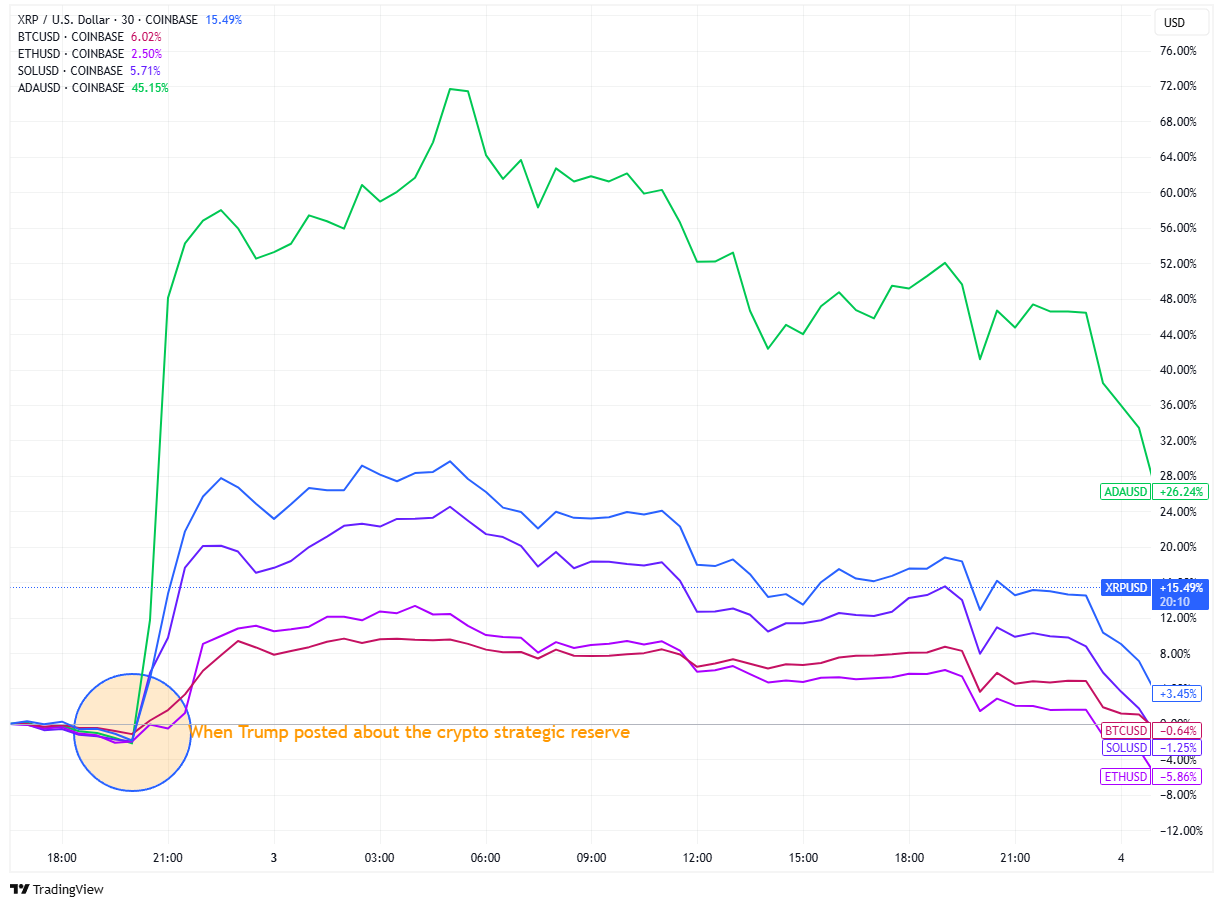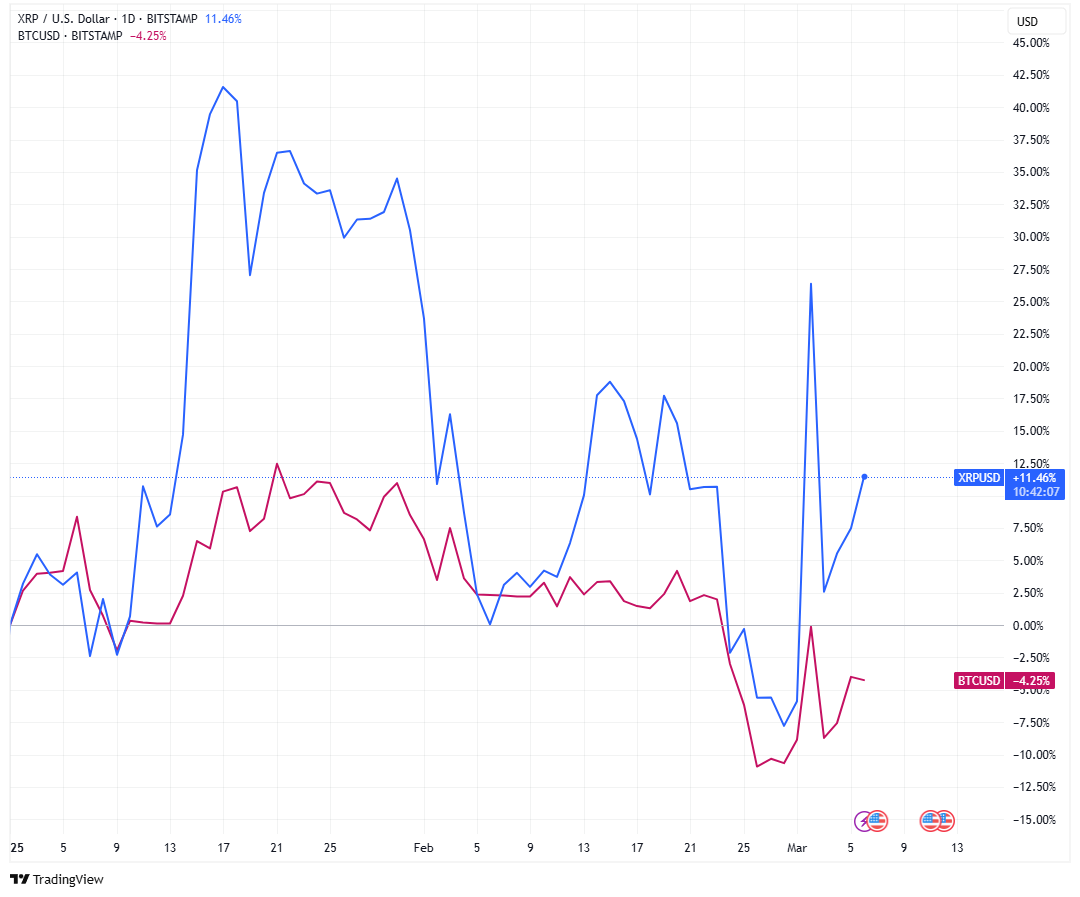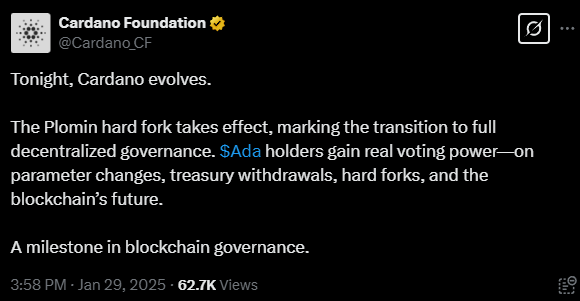Hello dispatchers!
The anticipation is high within the crypto circles as we stand a day away from the first-ever crypto summit to be hosted by the White House.
US President Donald Trump’s initial announcement about the "crypto strategic reserve" got all the currencies including XRP, Solana, and Cardano alongside BTC and ETH soaring.
Well, at least, temporarily.
Fast forward three days, and the entire "Trump pump" has evaporated. Altcoins are struggling to make their case for inclusion. What the reserve holds for these altcoins is unknown, so far. It will stay that way until the summit tomorrow throws more light.
We were wondering what lies ahead for these altcoins.
Do these coins even need to be considered for inclusion in the reserve?
Is there something driving their long-term value besides the optimism around reserve?
Let’s see what's really moving the needle for Trump’s altcoin picks beyond the political hype.
Connect to Web3 Seamlessly, with WalletConnect!
Navigating Web3 can be confusing. Managing multiple wallets and dApps? Even trickier.
WalletConnect makes it effortless — allowing you to access thousands of dApps securely from any device.
Instantly connect your wallet to any dApp
Supports all major wallets and blockchains
Fully encrypted, ensuring top-tier security
No extensions, just scan and connect
Whether you're trading, gaming, or exploring DeFi, WalletConnect keeps you connected—safely and effortlessly.
The best part? It’s free, open-source, and built for the future of Web3.
The Trump Bounce and Reality Check
The cryptocurrency market's love-affair with presidential endorsements proved fleeting at best.
On Sunday, when President Trump posted on Truth Social that the US would create a "crypto strategic reserve" including ADA, SOL, and XRP, the market responded with a euphoric impulse. Bitcoin surged from $85,000 to nearly $95,000, but it was the altcoins that truly went parabolic.
Cardano shot 72%, Solana and XRP weren't far behind, with gains of 40% and 24% respectively. The market's initial reaction seemed to validate the thesis that presidential endorsement could reshape these assets' trajectories.
It wasn’t to be though.
Get 17% discount on our annual plans and access our weekly premium features (HashedIn, Wormhole, Rabbit hole and Mempool) and subscribers only posts. Also, show us some love on Twitter and Telegram.
They all came crashing down in 24 hours, paring almost all gains they made.
The collapse was swift. The pattern was clear – what the president giveth with a Sunday tweet, macro realities taketh away by Tuesday.
The narrative started falling apart soon as the industry launched a scathing attack criticising Trump’s inclusion of altcoins.
Read: Crypto Industry’s Not Buying into Trump’s Reserve Plans
Ironically, the market movement made little sense fundamentally. The reserve announcement was light on implementation details, yet managed to send the affected coins to soaring heights. Meanwhile, the market ignored all the significant development milestones and institutional interest the coins have achieved, in their hasty retreat.
This volatility highlighted a crucial question: beyond presidential tweets and short-term speculation, what's actually driving these assets' value propositions in 2025?
XRP: Beyond the Presidential Endorsement
XRP's momentary pump and subsequent dump overshadows a potentially more significant development — surging confidence in an XRP ETF approval.
On prediction platform Polymarket, Trump's reserve announcement triggered an 8-percentage-point jump in the odds of an XRP ETF getting SEC approval this year, now standing at 76%.
"Including XRP in a strategic reserve strengthens the case for XRP ETF applications by helping to resolve some key regulatory concerns," Jonathan de Wet, chief investment officer at crypto trading firm Zerocap, told DL News.
The stakes couldn't be higher. JPMorgan analysts predicted XRP ETFs could attract up to $8 billion in investor flows within their first year — a capital influx that would dwarf any speculative buying from a presidential endorsement.
Currently, five major asset managers — 21Shares, Grayscale, CoinShares, WisdomTree, and Canary Capital — have active ETF applications for XRP under SEC review. The agency has until mid-October to render decisions, though expectations are growing for earlier approvals given the agency's increasingly crypto-friendly stance.
This regulatory shift comes amid a wave of SEC case dismissals that has transformed the landscape for XRP.
After Ripple's partial victory in its long-running SEC lawsuit last year, the agency's recent withdrawal from cases against Coinbase, Kraken, and others signals a dramatic policy reversal that benefits XRP perhaps more than any other cryptocurrency.
Read: Case Closed: SEC’s Crypto Cleanup🧹
From a technical perspective, XRP has been testing the critical $3 resistance level, with on-chain data showing accumulation at current prices. While the coin has retreated to its 20-day exponential moving average around $2.50, this level serves as important support. Sustained trading above this mark would indicate continued bullish momentum despite the recent pullback.
XRP has consistently outperformed Bitcoin in 2025, rising more than 10% year-to-date compared to Bitcoin's more than 3% decline. This suggests investor confidence in XRP's fundamentals beyond short-term political narratives.
The moot point is - does XRP even need inclusion in any strategic reserve when institutional adoption through ETFs offers a more concrete and immediate catalyst?
The reserve, although announced and imminent, still requires Congressional approval and funding. ETFs have a proven case for mainstream adoption with established timelines and mechanisms already existing.
Solana: DeFi Giant with Undervalued Tokens
While Solana's price action has been volatile, a compelling investment thesis emerges from Wall Street giant Franklin Templeton.
In a research report released Tuesday, Franklin Templeton highlighted a striking valuation disconnect in the DeFi ecosystem. Solana's DeFi tokens are trading at substantially lower multiples than their Ethereum counterparts despite delivering dramatically superior growth.
"Solana DeFi valuation multiples trade on average lower than their Ethereum counterparts despite significantly higher growth profiles, highlighting an apparent valuation asymmetry," the report stated.
Franklin Templeton compared tokens of five leading ETH projects (LDO, AAVE, ENA, MKR and UNI) to five of Solana's strongest protocols (JTO, JUP, KMNO, MNDE and RAY). The Solana projects saw 2,400% median growth in fees year over year, yet trade at a modest 9x multiple. Meanwhile, Ethereum projects grew just 150% but command an 18x multiple.
This valuation gap points to potential upside for Solana's DeFi ecosystem that transcends any presidential endorsement. The report even suggested that "DeFi may be entering an era of Solana Virtual Machine Dominance, shifting away from the historical reign of EVM based DeFi."
Beyond DeFi, institutional interest in Solana continues to grow despite recent price volatility.
The Chicago Mercantile Exchange (CME) is gearing up to launch Solana futures, which will provide regulated exposure for institutional traders who have been awaiting compliant investment vehicles.
It won’t be a smooth ride, though. Solana faces headwinds in its core metrics. Active addresses have declined to 8.4 million by late February, from 18.5 million in November.
The pump.fun platform, which drove much of Solana's activity in 2024, has seen a 63% drop in trading volume last month as memecoin enthusiasm wanes.
Read: Game, Set and Death for Memecoins?💀
Technically, Solana is struggling to maintain support above its 20-day EMA ($167), with resistance at $180. Market analysts identify the $125 level as crucial support, with significant downside risk if this level fails.
Yet, the industry is expecting the Solana ETF approval to go through, with multiple applications under SEC review.
For Solana, the presidential endorsement may ultimately prove less consequential than closing the valuation gap with Ethereum and securing regulated institutional access through ETFs and futures contracts.
Cardano: Governance Revolution in Progress
Cardano's price whipsawed from Trump's announcement and was the biggest gainer among the five cryptocurrencies.
Beyond the fortunes tied with the crypto reserve, the blockchain is betting on its most recent upgrade that had far reaching implications in terms of governance.
On January 31, Cardano activated the Plomin hard fork.
This governance revolution represents the culmination of Cardano's methodical development approach. By giving ADA holders direct influence over the protocol's evolution, Cardano has positioned itself as one of the most decentralised blockchains in the space — a credential that may prove more valuable than any presidential recognition.
The most promising for Cardano's future are its prospects of institutional adoption.
On February 11, NYSE Arca filed on behalf of Grayscale to launch a spot Cardano ETF. If approved, this would mark Grayscale's first standalone investment product for Cardano and potentially open the floodgates for institutional capital.
Token Dispatch View 🔍
The Trump-induced altcoin roller coaster reveals a fundamental truth about crypto's evolution in 2025: presidential tweets now function more as sentiment indicators than genuine catalysts for sustainable value.
They will most likely induce a pump in the prices of tokens, albeit extremely short-lived ones. The rapid evaporation of the "Trump pump" across XRP, Solana, and Cardano demonstrates this.
The strategic reserve announcement, while headline-grabbing, faces significant hurdles. Congressional approval, funding mechanisms, and implementation details remain entirely undefined.
Commerce Secretary Howard Lutnick’s recent clarification about Bitcoin’s special status in the upcoming crypto reserve further reinforces the point that altcoins may have to look at fundamentals for long term value drivers.
As the White House Crypto Summit approaches, investors would be wise to look beyond tomorrow's headlines to the structural developments reshaping these assets' trajectories.
The value drivers for XRP, Solana, and Cardano won't come from Pennsylvania Avenue but from Wall Street's capital flows, developer innovation, and institutional adoption mechanisms that are already well underway.
Token Dispatch is a daily crypto newsletter handpicked and crafted with love by human bots. You can find all about us here 🙌
If you want to reach out to 200,000+ subscriber community of the Token Dispatch, you can explore the partnership opportunities with us.
Disclaimer: This newsletter contains sponsored content and affiliate links. All sponsored content is clearly marked. Opinions expressed by sponsors or in sponsored content are their own and do not necessarily reflect the views of this newsletter or its authors. We may receive compensation from featured products/services. Content is for informational purposes only, not financial advice. Trading crypto involves substantial risk - your capital is at risk. Do your own research.















